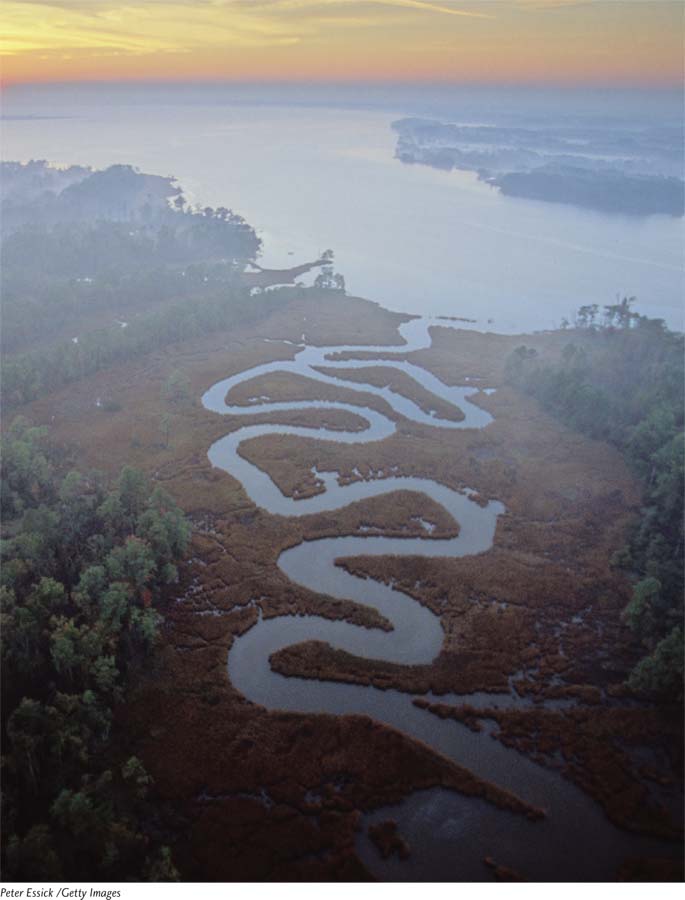Chapter Introduction
chapter 14
Water Pollution

The Chesapeake Bay
The Chesapeake Bay is the largest estuary in the United States and it faces some of the biggest environmental challenges. Located between the states of Virginia and Maryland, the Chesapeake Bay receives fresh water from numerous rivers and streams that mixes with the salt water of the ocean to produce an extremely productive estuary. Many of the rivers and streams that dump into the bay travel long distances and drain water from a large watershed of urban, suburban, and agricultural areas. Indeed, the watershed that supplies the bay extends from northern Virginia all the way up into central New York State. One of the consequences of receiving water from such a large watershed is that the water coming into the bay contains an abundance of nutrients, sediments, and chemicals.
Anthropogenic chemicals appeared to be responsible for 82 percent of male smallmouth bass developing into hermaphrodites.
Among the major nutrients that enter the bay each year are 272 million kg (600 million pounds) of nitrogen and 14 million kg (30 million pounds) of phosphorus. The nitrogen and phosphorus come from three major sources. The first source is water discharged from sewage treatment facilities; it carries high amounts of nutrients from human waste. The second source is animal waste produced by concentrated animal feeding operations; these operations generate large amounts of manure that can make their way into nearby streams and rivers. The third source is fertilizer that is spread on both agricultural fields and suburban lawns; much of this fertilizer leaches out of the soil and into local streams that eventually flow into the Chesapeake Bay. When these nutrients reach the bay, the algae in the bay experience an explosive population growth that is known as an algal bloom.
Increased sediments are also an issue in the Chesapeake Bay. Sediments are soils washed away from fields and forests as well as soils washed away from the banks of streams and the ocean shoreline. According to current estimates, 8.2 billion kilograms (18.7 billion pounds) of sediments come into the bay each year. The tiniest soil particles stay suspended in the water, make the water cloudy, and prevent sunlight from reaching the grasses that historically have been abundant in the bay. These grasses are important because they serve as a habitat for fish and blue crabs (Callinectes sapidus). Over the past several decades, the blue crab population has experienced substantial declines.
Inputs of anthropogenic chemicals, including pesticides and pharmaceutical drugs, are also prevalent. Pesticides arrive in the bay by direct application over water, by running off the surface of the land when it rains, or by being carried by the wind immediately after application. Pharmaceuticals pass through the human body and enter sewage treatment plants that eventually discharge into the streams and rivers that feed the bay. In 2009, the U.S. Fish and Wildlife Service announced that estrogen from sewage in the water was the most likely reason that 23 percent of male largemouth bass and 82 percent of male smallmouth bass developed into hermaphrodites; their male sex organs grow eggs, a function that normally only occurs in the sex organs of female fish. This impact not only concerns fish, but also is a concern for humans who share many similarities in their reproductive systems and may consume water contaminated with estrogens.
Because the Chesapeake Bay watershed is so large, cleaning it up has required a sustained and monumental effort. In 2000, the states surrounding the Chesapeake Bay formed a partnership along with multiple federal departments to develop the Chesapeake Bay Action Plan. This plan outlines a series of goals to reduce the impacts of nutrients, sediments, and chemicals coming into the bay. An assessment in 2010 concluded that many of the Action Plan’s goals were being met, including a reduction in nitrogen, an increase in water clarity, and an increase in the number of blue crabs. Overall, the improved water quality combined with limits in the blue crab harvest allowed the blue crab population to increase dramatically. In 2012, the blue crab population in the bay reached its highest density in 20 years. In 2013, the total population size declined, but biologists were encouraged to discover that the remaining population had a higher proportion of reproductively mature females, which suggested that the future of the blue crab population looked bright. Much more work still needs to be done, such as resolving the problem of anthropogenic chemicals that cause hermaphroditic smallmouth bass.
The story of the Chesapeake Bay serves as an excellent example of the wide variety of pollutants that can impact aquatic ecosystems and of effective and substantial efforts that can only be made when all parties work together toward a common goal.
Sources: Chesapeake Bay Program, http:/
Water pollution The contamination of streams, rivers, lakes, oceans, or groundwater with substances produced through human activities.
Water is a key resource for life on Earth. All organisms, including humans, require water to live, but increases in human populations combined with industrialization have led to the contamination of water supplies. Water pollution is generally defined as the contamination of streams, rivers, lakes, oceans, or groundwater with substances produced through human activities. As we will see, water pollution occurs from a wide range of substances from various sources. The prevalence and impact of pollutants in water also varies. Although this chapter focuses on the contaminants that exist in water and their effects on aquatic organisms and humans, because there are many ecological connections between aquatic and terrestrial ecosystems, water pollution can also affect terrestrial organisms.
The broad range of pollutants that can be found in water includes human and animal waste, inorganic substances, organic compounds, synthetic organic compounds, and nonchemical pollutants. In this chapter we will consider the origin of each category of pollutant, its negative effects on humans and the environment, and what can be done to reduce the pollutant.